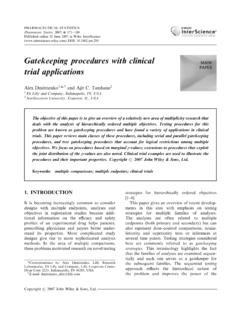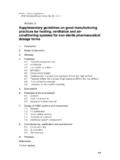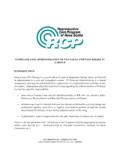Transcription of Exploratory assessment of dose proportionality: …
1 PHARMACEUTICAL STATISTICSP harmaceut. Statist.(2008)Published online in Wiley InterScience( ) DOI: assessment of doseproportionality: review of currentapproaches and proposal for a practicalcriterionJu rgen Hummel1,*,y, Sue McKendrick2, Charlie Brindley3andRaymond French41 PPD, Bellshill, Lanarkshire, Scotland, UK2 AAI Pharma Ltd, Edinburgh, Scotland, UK3 KinetAssist Ltd, Quothquan, Lanarkshire, Scotland, UK4 Charles River Laboratories Preclinical Europe, Tranent, Edinburgh, Scotland, UKThis article reviews currently used approaches for establishing dose proportionality in Phase I doseescalation studies.
2 A review of relevant literature between 2002 and 2006 found that the power modelwas the preferred choice for assessing dose proportionality in about one-third of the articles. Thisarticle promotes the use of the power model and a conceptually appealing extension, a criterionbased on comparing the 90% confidence interval for the ratio of predicted mean values from theextremes of the dose range Rdnm to pre-defined equivalence criterion !L;!U :The choice ofbioequivalence default values of!L= and!U= seems reasonable for dose levels only adoubling apart but are impractically strict when applied over the complete dose range.
3 Powercalculations are used to show that this prescribed criterion lacks power to conclude doseproportionality in typical Phase I dose -escalation studies. A more lenient criterion with values!L=0:5 and!U=2 is proposed for Exploratory dose proportionality assessments across the completedose range. Copyright#2008 John Wiley & Sons, :pharmacokinetics; Exploratory dose proportionality ; power model; equivalence criterion;power calculations1. INTRODUCTIONThe investigation of the pharmacokinetic (PK)properties of a compound typically includes anyE-mail: to: Ju rgen Hummel, PPD, Fleming House,Phoenix Crescent, Strathclyde Business Park, Bellshill, Lanark-shire ML4 3NJ, Scotland, #2008 John Wiley & Sons, of dose proportionality .
4 In essence, thisinvestigates whether anr-fold increase in doseleads to anr-fold increase in total or maximalsystemic exposure, measured by the PK para-meters AUC andCmax: dose proportionality is adesirable property as it makes predicting the effectsof dose adjustments easier, although in practicethis is not a global property as it usually appliesonly to a certain dose proportionality is often assessed at twodifferent stages of the drug development Exploratory assessment of approximate doseproportionality is often carried out using PK datafrom first time in human (FTIH) studies, whereasa definitive assessment of confirmatory doseproportionality is generally conducted duringPhase II or III [1].
5 2. DESIGN OF FTIH STUDIESW hile there is FDA guidance on the estimation ofthe starting dose in healthy volunteer studies [2], nosuch guidance exists on the design of FTIH studies,and as a result there is considerable variety in howsuch studies are conducted. A report with 21recommendations on the design and analysis ofFTIH studies [3, 4] was issued recently following theunfortunate outcome of the FTIH study conductedat Northwick Park Hospital in March , increasing doses are administered to3 10 healthy volunteers per dose with a smallnumber of concurrent subjects administered pla-cebo (see [1, 5]).
6 Single and repeat administrationsare investigated separately. Patterson and Jones [1]state that, cross-over designs are generally em-ployed for the purposes of informative dose -escalation in FTIH and Phase I studies . Thiswas not backed up by our experience gained inFTIH studies in different Contract ResearchOrganizations (CROs) or by Buoenet al.[5],who conducted a survey of 105 Phase I dose -escalation trials in healthy volunteers between1995 and 2004 and found ascending dose designwith independent cohorts ( parallel design ) themost frequent design within all therapeutic designs are likely to be more popularbecause the study duration for each subject isconsiderably shorter, reducing the likelihood ofpremature flexible study designs have been proposedfor Phase I oncology studies, where the dose levelallocated to the next cohort of patients depends onthe toxicities observed in the patients to date andwhere dose levels do not necessarily increase [6 9]
7 ,but they have not yet been applied very frequentlyto Phase I healthy volunteer REVIEW OF CURRENTLY USEDSTATISTICAL ANALYSISMETHODOLOGY FOR OptionsDifferent statistical analysis approaches can beused for the assessment of dose proportionality [10, 11]. The following options are investigated inmore depth in this section:(a) dose normalizationof the PK parameterfollowed by an analysis of variance (ANOVA)(or an equivalent non-parametric test) on log-transformed data to test for differences be-tween dose levels. This is done either using anoverall test ( ) and/or several pair-wise comparisons (which may be presented asconfidence intervals (CIs) for the ratios of dosenormalized geometric means).
8 (b)Weighted simple linear regressionbetween thePK parameter y and dosey a bdosewhere the hypothesis thata 0 is tested andthe lack of fit of the model is generally testedby adding a quadratic term.(c)Power modelproposed by Goughet al.[12].The relationship between the PK parameter y and dose is defined as follows:y adosebThis becomes a linear relationship following alogarithmic transformation, to which a linearCopyright#2008 John Wiley & Sons, Statist.(2008)DOI: Hummelet approach can be applied:log y m blog dose Assuming that the underlying relationshipbetween log y and log dose is linear, a valueof 1 forbindicates perfect dose proportion-ality.
9 Therefore, the estimate ofbtogetherwith a suitable CI can be used to quantify doseproportionality.(d)Equivalencecriter ion: On the basis ofthe criterion suggested by the FDA andEMEA guidelines for the assessment ofbioequivalence [13, 14], Smithet al.[15]propose a criterion for dose proportionalitybased on 90% CI for the ratio ofdose normalized means Rdnm lying withinpre-specified limits WL;WU :Different ap-proaches can be used to estimateRdnm:Inthe case of the power model,Rdnmcan beestimated asrb 1whereris the ratio of thehighest to the lowest dose , and comparing the90% CI aroundRdnmto pre-specified limits WL;WU is mathematically equivalent to com-paring the 90% CI aroundbto the limits bL;bU 1 ln WL ln r.
10 1 ln WU ln r While no specific values are advocatedforWLandWUin [15], the article statesthe choice should be based on safety,efficacy or drug registration considerationsand provides an example using the and as in the FDA guideline Literature reviewA list of 85 articles was obtained from a literaturesearch using Pubmed ( ) with the keyword dose proportionality , limited to Humans, lan-guage English and publication dates between 1 January 2002 and 31 December 2006. Since wewere interested in applications to dose -escalationstudies rather than studies that, for example,assessed different formulations, we restricted ourreview to the 50 articles [16 65] where there werethree or more dose levels of the same summary of this review is shown in Table that some papers used more than one ofthe approaches (a) (d).





